Windows AntiVirus Tool is a computer virus, which pretends to be a legitimate security program and claims that malware has been detected on your computer. If you try to remove these infections, Windows AntiVirus Tool will state that you need to buy its full version before being able to do so.
It’s important to remember that by purchasing Windows AntiVirus Tool you will be submitting your personal information to unscrupulous persons and may also end up being a victim of credit card or identity fraud or theft.

Windows AntiVirus Tool targets users browsing Internet websites, and rely on social engineering to deliver its payload. This infection is promoted through web sites that have been hacked with scripts that try to install the software by exploiting vulnerabilities on your computer. It is also promoted through Trojans that pretend to be legitimate programs that are required to view an online video, but instead it will install the Windows AntiVirus Tool infection.
Once installed, Windows AntiVirus Tool will display fake security alerts that are designed to think that your data is at risk or that your computer is severely infected.These messages may include:
Error
Trojan activity detected. System integrity at risk.
Full system scan is highly recommended.Error
System data security is at risk!
To prevent potential PC errors, run a full system scan.
In reality, none of the reported issues are real, and are only used to scare you into buying Windows AntiVirus Tool and stealing your personal financial information.
As part of its self-defense mechanism, Windows AntiVirus Tool has disabled the Windows system utilities, including the Windows Task Manager and Registry Editor, and will block you from running certain programs that could lead to its removal.
This rogue antivirus has also modified your Windows files associations, and now whenever you are trying to open a program, Windows AntiVirus Tool will block this operation and display a bogus notification in which will report that the file is infected.
Firewall has blocked a program from accessing the Internet
Internet Explorer
C:\Windows\system32\iexplore.exe
is suspected to have infected your PC.
This type of virus intercepts entered data and transmits them
to a remote server.
If your computer is infected with Windows AntiVirus Tool virus, then you are seeing the following screens:


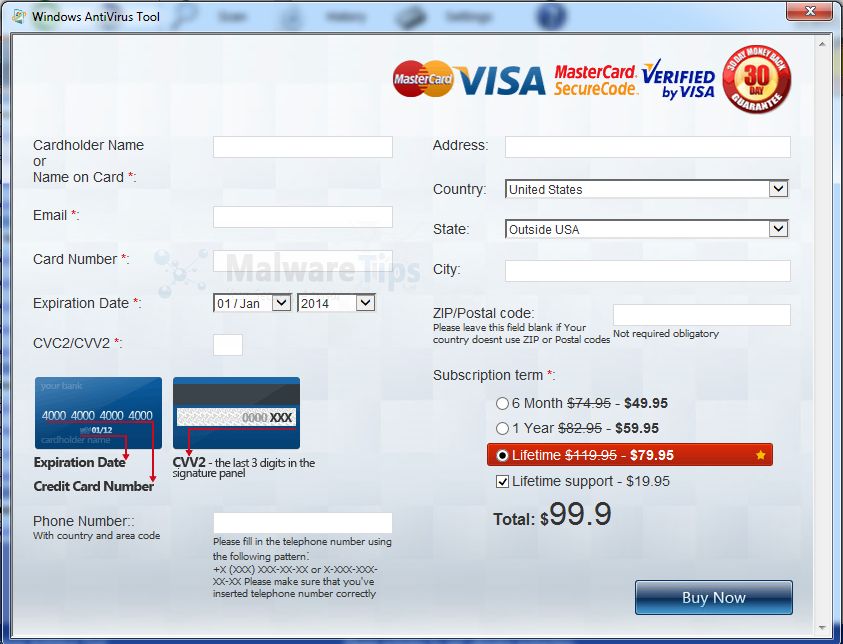
Windows AntiVirus Tool is a scam, and you should ignore any alerts that this malicious software might generate.
Under no circumstance should you buy Windows AntiVirus Tool as this could lead to identity theft, and if you have, you should contact your bank and dispute the charge stating that the program is a scam and a computer virus.
This Article Contains:
How to remove Windows AntiVirus Tool virus (Removal Guide)
This page is a comprehensive guide, which will remove the Windows AntiVirus Tool infection from your your computer. Please perform all the steps in the correct order. If you have any questions or doubt at any point, STOP and ask for our assistance. Please keep in mind that to perform this removal guide, you will need a clean (non-infected) computer and a CD or USB stick.
OPTION 1: Remove Windows AntiVirus Tool virus using its activation code
OPTION 2: Remove Windows AntiVirus Tool virus by fixing your Windows Registry
OPTION 3:Remove Windows AntiVirus Tool virus with System Restore
OPTION 1: Remove Windows AntiVirus Tool virus using its activation code
STEP 1: Use the Windows AntiVirus Tool activation key to stop its malicious behavior
Windows AntiVirus Tool has hijacked your Windows Registry to launch itself before any application and stop you from running any other program. To prevent this from happening, we can use the below code to register Windows AntiVirus Tool.
- Open Windows AntiVirus Tool interface, click on the question mark button in the right top corner, then click on Register button.
![Click on the question mark and select Register [Image: Click on the question mark and select Register]](data:image/gif;base64,R0lGODlhAQABAAAAACH5BAEKAAEALAAAAAABAAEAAAICTAEAOw==)
- When the Windows AntiVirus Tool Registration box will pop-up, enter the below registration codes to activate this rogue antivirus.
Windows AntiVirus Tool Product Key: 0W000-000B0-00T00-E0021

- Windows AntiVirus Tool should now allow Windows to start, and you should be able to open your browser and any other programs.
Please keep in mind that entering the above registration code will NOT remove Windows AntiVirus Tool from your computer, instead it will just stop the fake alerts so that you’ll be able to complete this removal guide without being interrupted by this infection.
STEP 2: Remove Windows AntiVirus Tool virus with Malwarebytes Anti-Malware FREE
Malwarebytes Anti-Malware Free is a powerful on-demand scanner which will remove Windows AntiVirus Tool malicious files from your computer.
- You can download Malwarebytes Anti-Malware Free from the below link, then double-click on the icon named mbam-setup.exe to install this program.
MALWAREBYTES ANTI-MALWARE DOWNLOAD LINK(This link will open a download page in a new window from where you can download Malwarebytes Anti-Malware Free) - When the installation begins, keep following the prompts in order to continue with the setup process, then at the last screen click on the Finish button.
![Malwarebytes Anti-Malware installation screen [Image: Malwarebytes Anti-Malware final installation screen]](data:image/gif;base64,R0lGODlhAQABAAAAACH5BAEKAAEALAAAAAABAAEAAAICTAEAOw==)
- On the Scanner tab, select Perform quick scan, and then click on the Scan button to start searching for the Windows AntiVirus Tool malicious files.
![Run a Quick Scan with Malwarebytes Anti-Malware [Image: Malwarebytes Anti-Malware Quick Scan]](data:image/gif;base64,R0lGODlhAQABAAAAACH5BAEKAAEALAAAAAABAAEAAAICTAEAOw==)
- Malwarebytes’ Anti-Malware will now start scanning your computer for Windows AntiVirus Tool virus as shown below.

- When the Malwarebytes Anti-Malware scan has finished, click on the Show Results button.
![Malwarebytes when the system scan has completed [Image: Malwarebytes Anti-Malware scan results]](data:image/gif;base64,R0lGODlhAQABAAAAACH5BAEKAAEALAAAAAABAAEAAAICTAEAOw==)
- You will now be presented with a screen showing you the computer infections that Malwarebytes Anti-Malware has detected. Make sure that everything is Checked (ticked), then click on the Remove Selected button.
![Malwarebytes Anti-Malwar removing Windows AntiVirus Tool virus [Image: Malwarebytes Anti-Malwar removing Windows AntiVirus Tool virus]](data:image/gif;base64,R0lGODlhAQABAAAAACH5BAEKAAEALAAAAAABAAEAAAICTAEAOw==)
- Once your computer will restart in Windows regular mode, open Malwarebytes Anti-Malware and perform a Full System scan to verify that there are no remaining threats.
STEP 3: Remove Windows AntiVirus Tool infection with HitmanPro
HitmanPro is a second opinion scanner, designed to rescue your computer from malware (viruses, trojans, rootkits, etc.) that have infected your computer despite all the security measures you have taken (such as anti virus software, firewalls, etc.). HitmanPro is designed to work alongside existing security programs without any conflicts. It scans the computer quickly (less than 5 minutes) and does not slow down the computer.
- You can download HitmanPro from the below link:
HITMANPRO DOWNLOAD LINK (This link will open a web page from where you can download HitmanPro) - Double-click on the file named HitmanPro.exe (for 32-bit versions of Windows) or HitmanPro_x64.exe (for 64-bit versions of Windows). When the program starts you will be presented with the start screen as shown below.

Click on the Next button, to install HitmanPro on your computer.

- HitmanPro will now begin to scan your computer for Windows AntiVirus Tool trojan.

- When it has finished it will display a list of all the malware that the program found as shown in the image below. Click on the Next button, to remove Windows AntiVirus Tool virus.

- Click on the Activate free license button to begin the free 30 days trial, and remove all the malicious files from your computer.
![HitmanPro free 30 days trial [Image: HitmanPro 30 days activation button]](data:image/gif;base64,R0lGODlhAQABAAAAACH5BAEKAAEALAAAAAABAAEAAAICTAEAOw==)
OPTION 2: Remove Windows AntiVirus Tool virus by fixing your Windows Registry
In some cases the above registration may not work, so we will need to fix your Windows Registry so that we can boot the computer without being blocked by the Windows AntiVirus Tool infection.
STEP 1 : Start your computer in Safe Mode with Command Prompt
- Remove all floppy disks, CDs, and DVDs from your computer, and then restart your computer.
- When the computer starts you will see your computer’s hardware being listed. When you see this information start to gently tap the F8 key repeatedly until you are presented with the Windows XP, Vista or 7 Advanced Boot Options.
![Windows F8 key [Image: F8 key]](data:image/gif;base64,R0lGODlhAQABAAAAACH5BAEKAAEALAAAAAABAAEAAAICTAEAOw==)
If you are using Windows 8, press the Windows key + C, and then click Settings. Click Power, hold down Shift on your keyboard and click Restart, then click on Troubleshoot and select Advanced options. In the Advanced Options screen, select Startup Settings, then click on Restart. Alternatively, you can read this guide to start Windows 8 in Safe Mode. - If you are using Windows XP, Vista or 7 in the Advanced Boot Options screen, use the arrow keys to highlight Safe Mode with Command Prompt , and then press ENTER.
![Advanced Boot Options screen [Image: Starting computer in Safe Mode with Command Prompt]](data:image/gif;base64,R0lGODlhAQABAAAAACH5BAEKAAEALAAAAAABAAEAAAICTAEAOw==)
If you are using Windows 8, press 6 on your keyboard to Enable Safe Mode with Command Prompt.
Windows will start in Safe Mode with Networking.
STEP 2: Fix your Windows Registry to remove Windows AntiVirus Tool and scan with Malwarebytes Anti-Malware and HitmanPro
Windows AntiVirus Tool has hijacked your Windows Registry to start automatically before your Windows desktop is shown, which makes your computer unusable until the infection is removed.
- While your computer is in Safe Mode with Command Prompt, the Command Prompt allows you to type commands and then press Enter on your keyboard to execute them.
In this Command Prompt window, please type explorer.exe and then press Enter on your keyboard.
![Type explorer.exe in Command Prompt [Image: Type explorer.exe in Command Prompt]](data:image/gif;base64,R0lGODlhAQABAAAAACH5BAEKAAEALAAAAAABAAEAAAICTAEAOw==)
- The Windows desktop will now appear. When the desktop appears you can then close the Command Prompt window by clicking on the X.
- Using a clean (non-infected) computer download onto a CD or USB stick the below program to fix your Windows Registry:
REGFIX DOWNLOAD LINK (This link will automatically download the registry fix for the Windows AntiVirus Tool infection) - Now insert your CD or USB drive into the infected machine and open up the drive letter associated with your inserted media. You can access this drive letter by opening the Computer icon on your desktop or from the Start Menu. Once the drive letter is open, double-click on the RegFix.reg and allow the data to be merged when you are prompted. Once the data has been merged, you can press the OK button and remove the removable media from your computer.
![Run RegFix.reg in Safe Mode with Networking [Image: Run RegFix.reg in Safe Mode with Networking]](data:image/gif;base64,R0lGODlhAQABAAAAACH5BAEKAAEALAAAAAABAAEAAAICTAEAOw==)
- Please reboot your computer into the normal Windows mode and login as the infected user. When you are back at your normal Windows desktop perform a scan with Malwarebytes Anti-Malware and HitmanPro as seen in OPTION 1.
OPTION 3: Remove Windows AntiVirus Tool virus with System Restore
System Restore helps you restore your computer’s system files to an earlier point in time. It’s a way to undo system changes to your computer without affecting your personal files, such as e‑mail, documents, or photos.
- Reboot your computer into Safe Mode with Command Prompt. To do this, turn your computer off and then back on and immediately when you see anything on the screen, start tapping the F8 key on your keyboard.
![Windows F8 key [Image: F8 key]](data:image/gif;base64,R0lGODlhAQABAAAAACH5BAEKAAEALAAAAAABAAEAAAICTAEAOw==)
If you are using Windows 8, the trick is to hold the Shift button and gently tap the F8 key repeatedly, this will sometimes boot you into the new advanced “recovery mode”, where you can choose to see advanced repair options. On the next screen, you will need to click on the Troubleshoot option, then select Advanced Options and select Windows Start-up Settings. Click on the Restart button, and you should now be able to see the Advanced Boot Options screen. - Using the arrow keys on your keyboard, select Safe Mode with Command Prompt and press Enter on your keyboard.
![Advanced Boot Options screen [Image: Starting computer in Safe Mode with Command Prompt]](data:image/gif;base64,R0lGODlhAQABAAAAACH5BAEKAAEALAAAAAABAAEAAAICTAEAOw==)
- At the command prompt, type rstrui.exe, and then press ENTER.
![rstrui.exe command in Safe Mode with Command Prompt [Image: Start System Restore to remove Windows AntiVirus Tool virus]](data:image/gif;base64,R0lGODlhAQABAAAAACH5BAEKAAEALAAAAAABAAEAAAICTAEAOw==)
Alternatively, if you are using Windows Vista, 7 and 8, you can type: C:\windows\system32\rstrui.exe , and press Enter. And if you are a Windows XP user, type C:\windows\system32\restore\rstrui.exe, then press Enter. - System Restore should start, and you will display also a list of restore points. Try using a restore point created just before the date and time the Windows AntiVirus Tool virus has infected your computer.
![Restore your computer's system files to an earlier point in time [Image: Restore settings to remove ransomware]](data:image/gif;base64,R0lGODlhAQABAAAAACH5BAEKAAEALAAAAAABAAEAAAICTAEAOw==)
- When System Restore has completed its task, start your computer in Windows regular mode, and perform a scan with Malwarebytes Anti-Malware and HitmanPro.
Your computer should now be free of the Windows AntiVirus Tool infection. If your current anti-virus solution let this infection through, you may want to consider purchasing the PRO version of Malwarebytes Anti-Malware to protect against these types of threats in the future, and perform regular computer scans with HitmanPro.
If you are still experiencing problems while trying to remove Windows AntiVirus Tool from your machine, please start a new thread in our Malware Removal Assistance forum.

![Click on the question mark and select Register [Image: Click on the question mark and select Register]](http://malwaretips.com/blogs/wp-content/uploads/2014/02/register-button.jpg)
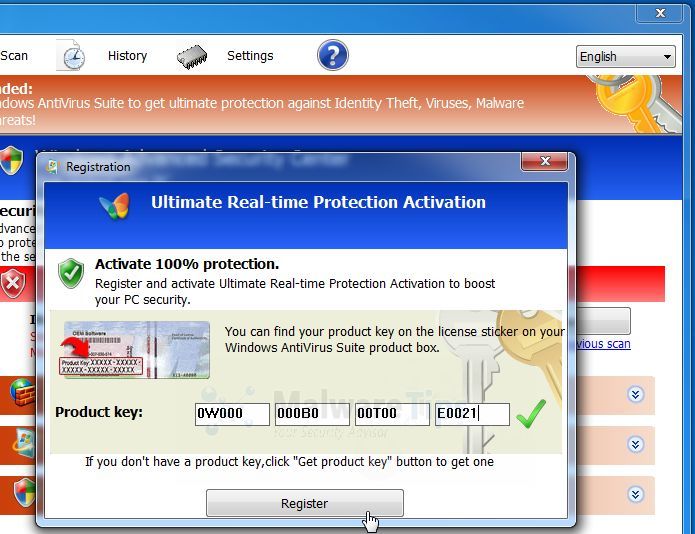
![Malwarebytes Anti-Malware installation screen [Image: Malwarebytes Anti-Malware final installation screen]](http://malwaretips.com/blogs/wp-content/uploads/2013/01/malwarebytes-installation.jpg)
![Run a Quick Scan with Malwarebytes Anti-Malware [Image: Malwarebytes Anti-Malware Quick Scan]](http://malwaretips.com/blogs/wp-content/uploads/2013/01/malwarebytes-quick-scan.jpg)
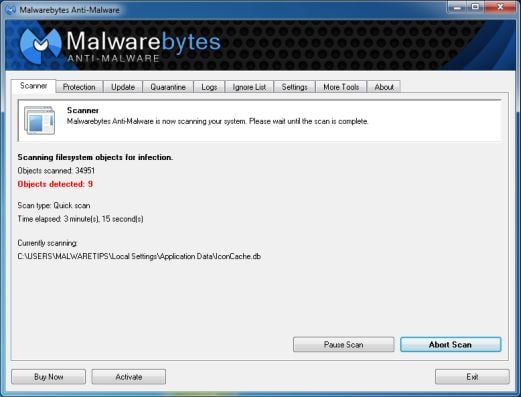
![Malwarebytes when the system scan has completed [Image: Malwarebytes Anti-Malware scan results]](http://malwaretips.com/blogs/wp-content/uploads/2013/01/malwarebytes-scan-results.jpg)
![Malwarebytes Anti-Malwar removing Windows AntiVirus Tool virus [Image: Malwarebytes Anti-Malwar removing Windows AntiVirus Tool virus]](http://malwaretips.com/blogs/wp-content/uploads/2013/01/malwarebytes-virus-removal.jpg)
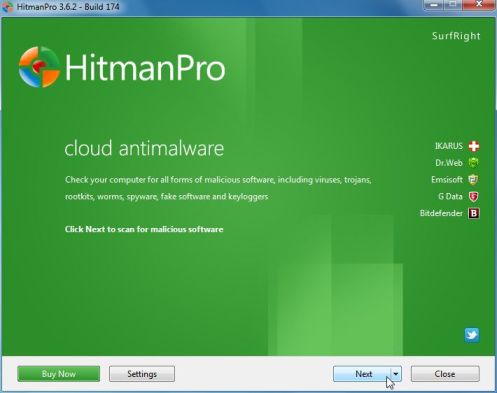
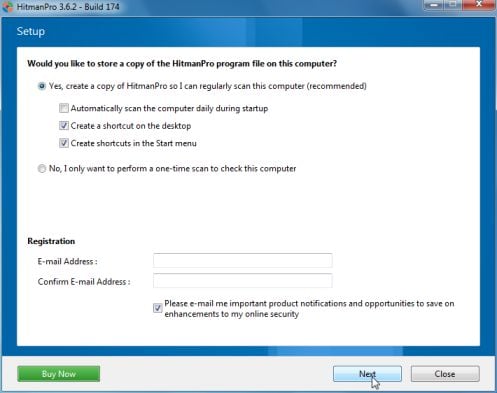
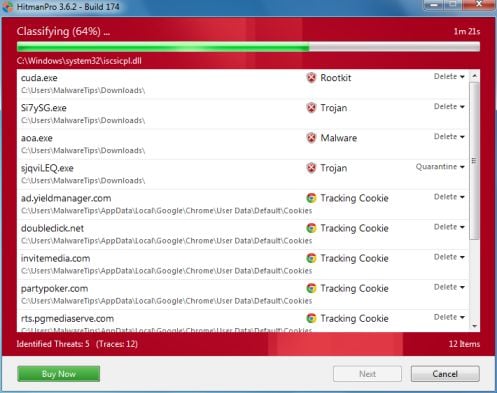
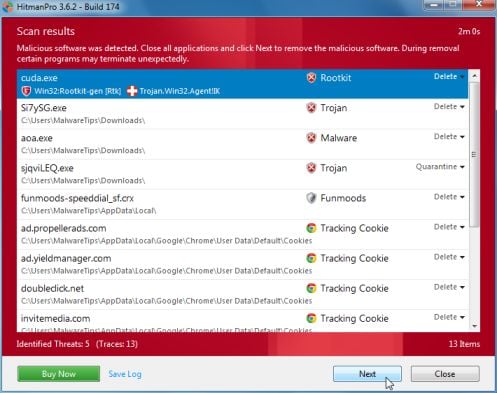
![HitmanPro free 30 days trial [Image: HitmanPro 30 days activation button]](http://malwaretips.com/blogs/wp-content/uploads/2012/11/hitmanpro-activation.jpg)
![Windows F8 key [Image: F8 key]](http://malwaretips.com/blogs/wp-content/uploads/2013/06/F8-key.jpg.png)
![Advanced Boot Options screen [Image: Starting computer in Safe Mode with Command Prompt]](http://malwaretips.com/blogs/wp-content/uploads/2013/06/Safe-Mode-with-Command-Prompt.jpg)
![Type explorer.exe in Command Prompt [Image: Type explorer.exe in Command Prompt]](http://malwaretips.com/blogs/wp-content/uploads/2013/11/explorer-exe-safe-mode-command-prompt.jpg)
![Run RegFix.reg in Safe Mode with Networking [Image: Run RegFix.reg in Safe Mode with Networking]](http://malwaretips.com/blogs/wp-content/uploads/2013/11/registry-fix.jpg)
![rstrui.exe command in Safe Mode with Command Prompt [Image: Start System Restore to remove Windows AntiVirus Tool virus]](http://malwaretips.com/blogs/wp-content/uploads/2013/06/system-restore-command.jpg)
![Restore your computer's system files to an earlier point in time [Image: Restore settings to remove ransomware]](http://malwaretips.com/blogs/wp-content/uploads/2013/06/system-restore.jpg)










MalwareBytes-HitmanPro due migliori programmi per rimuovere Ramwere Vurus